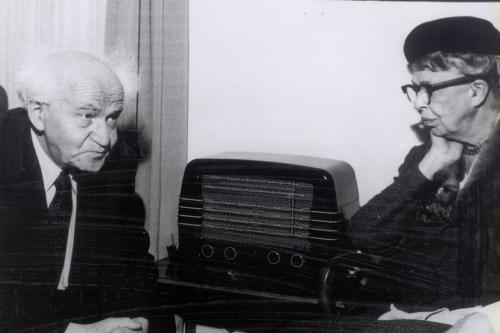Radio and Television
Eleanor Roosevelt rose to prominence at the dawn of the radio age. Her journalism career brought her on to radio before FDR took office, and she remained on the air until just before her death. Though radio and television constituted a major part of Roosevelt's conversation with the public, these sources have been hard to access and are rarely used by historians or heard by the public.
The Eleanor Roosevelt Papers Project has documented Roosevelt's career as a radio and television host, and to make as many of her programs as possible available to the public. We plan to include audio recordings of all of these transcribed materials in the near future.
These records are invaluable. They contain detailed discussions of the United States at the zenith of its historical influence, and they comment intimately of the politics, personalities and attitudes that infused it. They record Roosevelt's evolution from First Lady and budding journalist to political heavyweight and seasoned moderator.
Browse the Collection
Eleanor Roosevelt's Use of Radio and Television
- A Controversial Start to Radio
-
Beginning with her 13-appearance guest run on the Pond's Program in the interim between FDR's election and his inauguration, Roosevelt used radio in her capacity as a First Lady to communicate with the listening public and offer her point of view on everything from etiquette at the White House to foreign policy, often creating radio news programs specifically for a female audience. On her last Pond's appearance, Roosevelt assured her audience "that I shall always hope in one way or another to keep in touch with you, the American people, for I feel you are very close to me."
These early radio programs were fraught with controversy. While Lou Hoover had appeared on the radio more than once, Roosevelt's regular use of the media was an unprecedented as FDR's famous "fireside chats." After her series of 13 guest appearances on the Pond's Program, Roosevelt made a rule of not talking on commercial programs. The Pond's Program had elicited an "avalanche of letters" criticizing the soon-to-be First Lady for appearing on a sponsored program. Upon her move into the White House, Roosevelt announced that she would not lend her name to any advertising, and that her writings would not cover politics or the White House.
When she broke that rule, which she did in just over a year, she did so to raise funds for charities — her fee went directly to the charity of her choice. She did not read any advertisements herself, and her contracts specified that she be able to choose subjects without interference from those sponsors.
- Shift to Political Programming
-
As she became more comfortable in her combined roles as First Lady, political activist and journalist, Eleanor Roosevelt’s programs became more broadly and ostensibly political. They were less focused on those issues that might have been deemed, in the mode of the time, more “appropriate” for women. While her Pond's appearances had all dealt with women's roles in America, the New York Times described her role on her 1934 program for Simmons' Mattress company as her "debut" as a "current events new commentator." Her programs as First Lady swing back and forth between these two models, sometimes seeking to break down the barrier between the two. The Eleanor and Anna Roosevelt Program, which aired in 1948 and 1949, was the last targeted specifically at women.
- Transition to Television
-
Between April 1942 and November 1948, Roosevelt did not have a regular radio program, and when she returned to the airwaves after FDR's death it was to work on programs with two of her children: Anna and Elliott. They also coincided with her time as a delegate to the US Mission to the United Nations, and gave her another national platform from which to promote that work. Roosevelt moved smoothly into television in this time, as well, just as it began to gain a wide audience. Her first two television shows, Today with Mrs. Roosevelt and Mrs. Roosevelt Meets the Public, were Sunday news discussion programs. The second of these ran concurrently with the five-day-per-week radio program she co-hosted with Elliott Roosevelt, giving her an on-air presence six days a week. After these two programs ended in the summer of 1951, Roosevelt again left the airwaves for a prolonged period, returning over eight years later to host her last program, Prospects of Mankind.
- Acknowledgments
-
Unlike her career in print journalism, Roosevelt's radio career has been poorly documented. In the course of this project, the ERPP has uncovered many programs that had been lost to historians of the subject. We are greatly indebted to the librarians in the Recorded Sound Research Center of the Library of Congress, who helped us recreate episode lists and find transcripts for many of the early NBC programs. The archivists at the Franklin D. Roosevelt Library were also, as always, an enormous help in our search for the audio programs and print materials related to those shows. The National Endowment for the Humanities provided funding for this project through a Preservation and Access grant.


